
Mauritia flexuosa, known as the moriche palm, ité palm, ita, buriti, muriti, miriti (Brazil), canangucho (Colombia), morete (Ecuador), or aguaje (Peru), is a palm tree. It grows in and near swamps and other wet areas in tropical South America.

Adhemarius gannascus is a moth of the family Sphingidae first described by Caspar Stoll in 1790.

Mechanitis polymnia, the orange-spotted tiger clearwing or disturbed tigerwing, is a butterfly of the family Nymphalidae. It is found from Mexico to the Amazon rainforest. The wingspan is 65–75 mm (2.6–3.0 in). The larvae feed on Solanum species.

Heliconius doris, the Doris longwing or Doris is a species of butterfly in the family Nymphalidae. It is known for being a polymorphic species which participates in various Müllerian mimicry rings throughout Central America and the Amazon rainforest. It is a species of special interest in biological science for the genetic basis and role of polymorphism (biology) in ecology and evolution.

Anthanassa frisia, the Cuban crescentspot, Cuban checkerspot or Cuban crescent, is a butterfly of the family Nymphalidae. Subspecies tulcis is known by the common names pale-banded crescent or Tulcis crescent; it is treated as a species by some authors. The nominate subspecies is found in the West Indies and southern Florida, with strays to northern Florida. Subspecies tulcis is found from Argentina north through Central America and Mexico to southern Texas, strays to west Texas and southern Arizona. Other subspecies are resident to South America.
Langsdorfia franckii is a moth of the family Cossidae. It is native to Mexico, Nicaragua, Costa Rica, Panama, Colombia, Venezuela, Trinidad, Suriname, Ecuador, Peru, Bolivia and Brazil. It was researched for introduction in Hawaii to control Lantana, but no releases have been made.

Bia actorion, the uncertain owlet, bia owl or Actorion owlet, is a species of butterfly of the family Nymphalidae. It is found in the upper Amazon areas of Brazil, Ecuador, Peru and Bolivia.
Eupalamides guyanensis is a moth in the Castniidae family. It is widely distributed in northern South America, from Venezuela to Guyana, Colombia and Brazil (Pará).

Pyrisitia nise, the mimosa yellow, is a butterfly in the family Pieridae. It is found from Argentina north to the Texas Gulf Coast and throughout central and southern Florida, northward to the Tennessee Valley. It is an occasional stray to central Texas and south-eastern Arizona and rarely to southern California, southern Colorado and Kansas. The habitat consists of brushy woodland edges.

Pieriballia is a genus of butterflies in the family Pieridae erected by Alexander Barrett Klots in 1933. Its only species, Pieriballia viardi, the painted white or viardi white, was first described by Jean Baptiste Boisduval in 1836. It is found from Mexico to Bolivia and Paraguay. Strays can be found in southern Texas in the United States. The habitat consists of rainforests and transitional cloud forests.
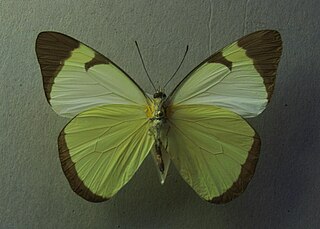
Melete lycimnia, the common melwhite, primrose flag or lycimnia white flag, is a butterfly in the family Pieridae. It is found from Texas in the United States to Bolivia. The habitat consists of lowland rainforests.

Itaballia pandosia, the Pisonis mimic or brown-bordered white, is a butterfly in the family Pieridae. It is found in the Amazonian regions of Brazil, Ecuador, Peru, and in Central America, Colombia and Venezuela. The habitat consists of primary rainforests. It may be a mimic of Moschoneura pinthous

Dismorphia crisia, the crisia mimic white or cloud forest mimic-white, is a butterfly in the family Pieridae. The species was first described by Dru Drury in 1782. It is found from northern Central America to Bolivia and the Amazon basin.
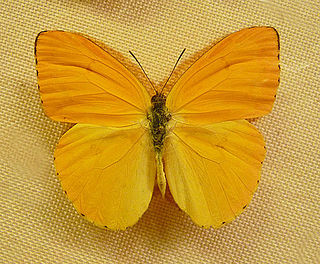
Phoebis argante, the apricot sulphur or Argante giant sulphur, is a butterfly in the family Pieridae.
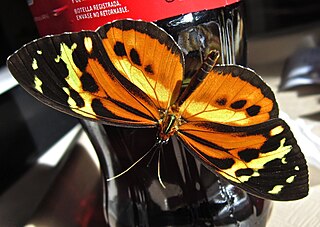
Tithorea harmonia, the Harmonia tiger-wing or Harmonia tiger, is a species of butterfly belonging to the family Nymphalidae.
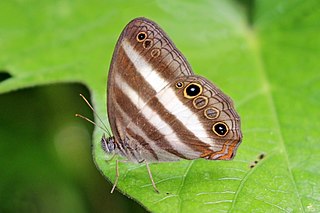
Pareuptychia ocirrhoe, the two-banded satyr or banded white ringlet, is a species of butterfly of the family Nymphalidae. It is found from Mexico to the Guyanas, Paraguay and northern Argentina. The habitat consists of forests.
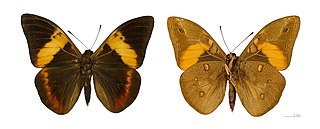
Brassolis sophorae is a species of large butterfly in the family Nymphalidae. It is found in South America.
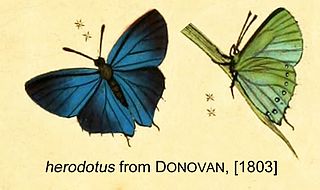
Cyanophrys herodotus, the tropical green hairstreak or tropical greenstreak, is a butterfly of the family Lycaenidae. It was described by Johan Christian Fabricius in 1793. It is found in Mexico, Guatemala, Panama, Nicaragua, Colombia, Ecuador, Peru, Bolivia, Brazil, Paraguay and Argentina. Rare strays can be found as far north as southern Texas. The habitat consists of open disturbed areas in tropical and subtropical rainforests and cloudforests at altitudes ranging from 600 to about 2,000 meters.

Heliconius ethilla, the ethilia longwing, is a butterfly of the family Nymphalidae. It was described by Jean-Baptiste Godart in 1819. It is found from Panama to southern Brazil. The habitat consists of marginal forests.
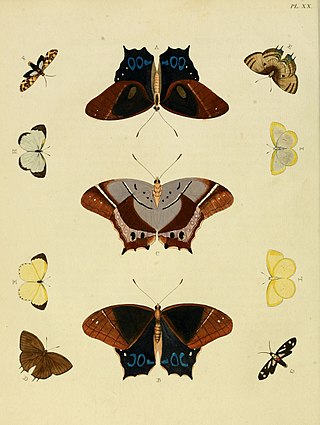
Antirrhea philoctetes, the common brown morpho or northern antirrhea, is a butterfly of the family Nymphalidae. It was described by Carl Linnaeus in 1758. It is found in Costa Rica, Panama, Guatemala, Colombia, Venezuela, the Guianas, Peru, Brazil and Bolivia.

















